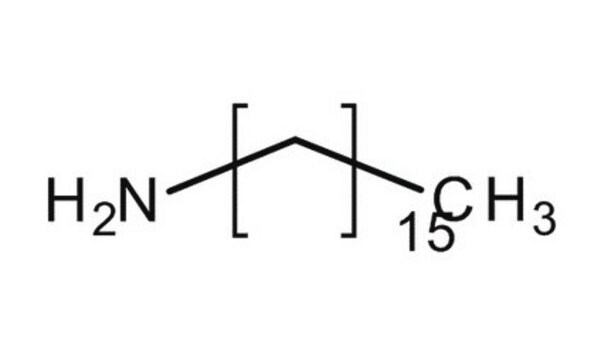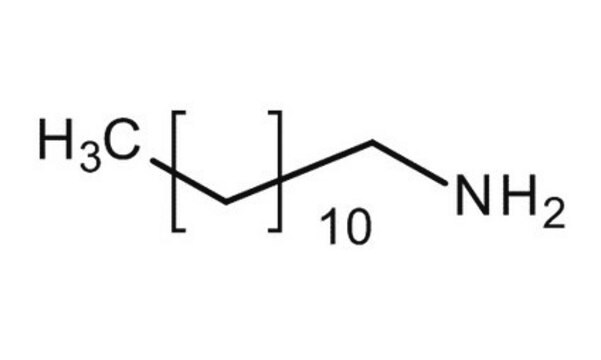H7408
Hexadecylamine
technical grade, 90%
Sinônimo(s):
1-Aminohexadecane, Cetylamine, HAD
About This Item
Produtos recomendados
grau
technical grade
pressão de vapor
<1 mmHg ( 20 °C)
Ensaio
90%
pb
330 °C (lit.)
pf
43-45 °C (lit.)
cadeia de caracteres SMILES
CCCCCCCCCCCCCCCCN
InChI
1S/C16H35N/c1-2-3-4-5-6-7-8-9-10-11-12-13-14-15-16-17/h2-17H2,1H3
chave InChI
FJLUATLTXUNBOT-UHFFFAOYSA-N
Procurando produtos similares? Visita Guia de comparação de produtos
Categorias relacionadas
Descrição geral
Aplicação
- Interfacial structuring of liquids: Hexadecylamine is explored for its role in the solvent-assisted interfacial association of oppositely charged polyelectrolytes and amphiphiles, offering potential advancements in the structuring of liquids for various industrial and scientific applications (Bak et al., 2023).
- Efficient light-to-thermal conversion: Additionally, hexadecylamine is used in ZnO nanorods loading with fatty amine as composite phase change materials (PCMs) device, enhancing light-to-thermal and electro-to-thermal energy conversion, applicable in energy storage technologies (Cao et al., 2023).
Palavra indicadora
Danger
Frases de perigo
Declarações de precaução
Classificações de perigo
Aquatic Acute 1 - Aquatic Chronic 1 - Asp. Tox. 1 - Eye Dam. 1 - Skin Corr. 1A - STOT RE 2
Órgãos-alvo
Gastrointestinal tract,Liver,Immune system
Código de classe de armazenamento
8A - Combustible corrosive hazardous materials
Classe de risco de água (WGK)
WGK 3
Ponto de fulgor (°F)
285.8 °F - closed cup
Ponto de fulgor (°C)
141 °C - closed cup
Equipamento de proteção individual
Eyeshields, Faceshields, Gloves, type P3 (EN 143) respirator cartridges
Certificados de análise (COA)
Busque Certificados de análise (COA) digitando o Número do Lote do produto. Os números de lote e remessa podem ser encontrados no rótulo de um produto após a palavra “Lot” ou “Batch”.
Já possui este produto?
Encontre a documentação dos produtos que você adquiriu recentemente na biblioteca de documentos.
Os clientes também visualizaram
Nossa equipe de cientistas tem experiência em todas as áreas de pesquisa, incluindo Life Sciences, ciência de materiais, síntese química, cromatografia, química analítica e muitas outras.
Entre em contato com a assistência técnica
















